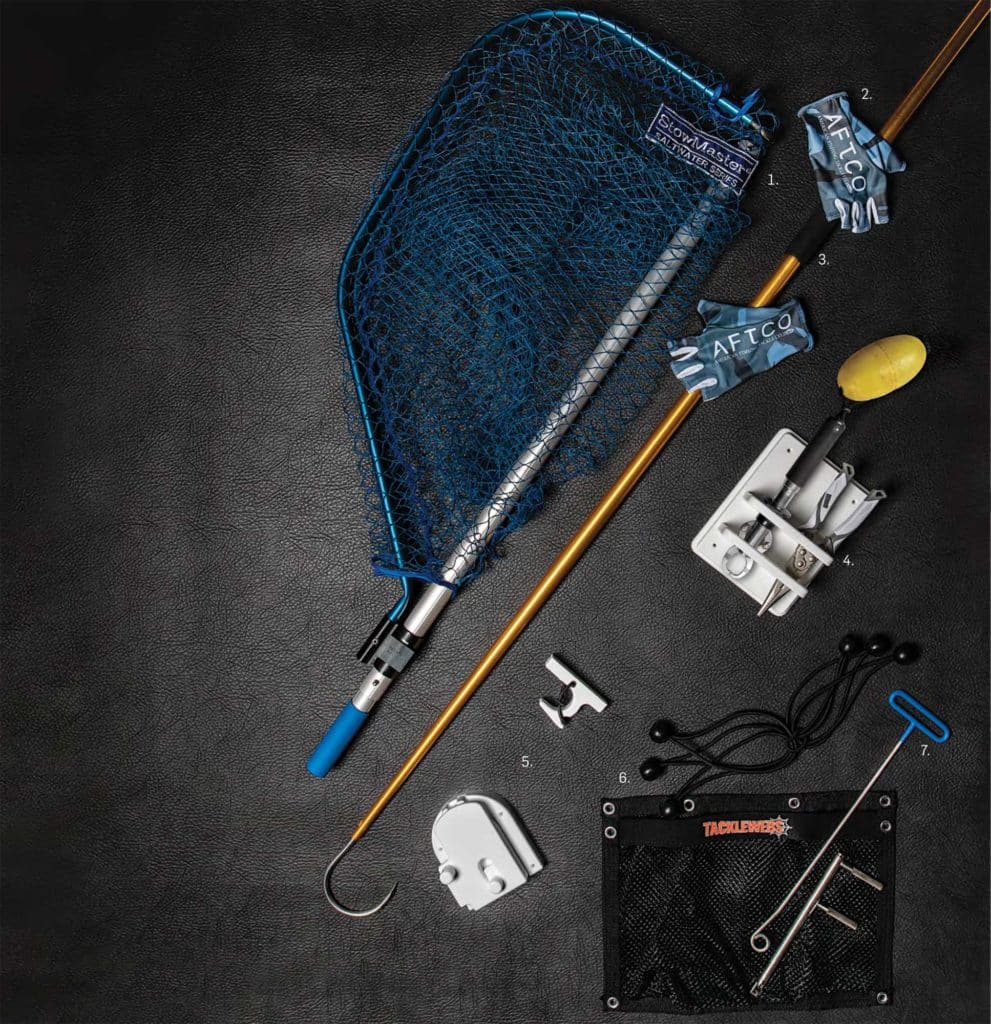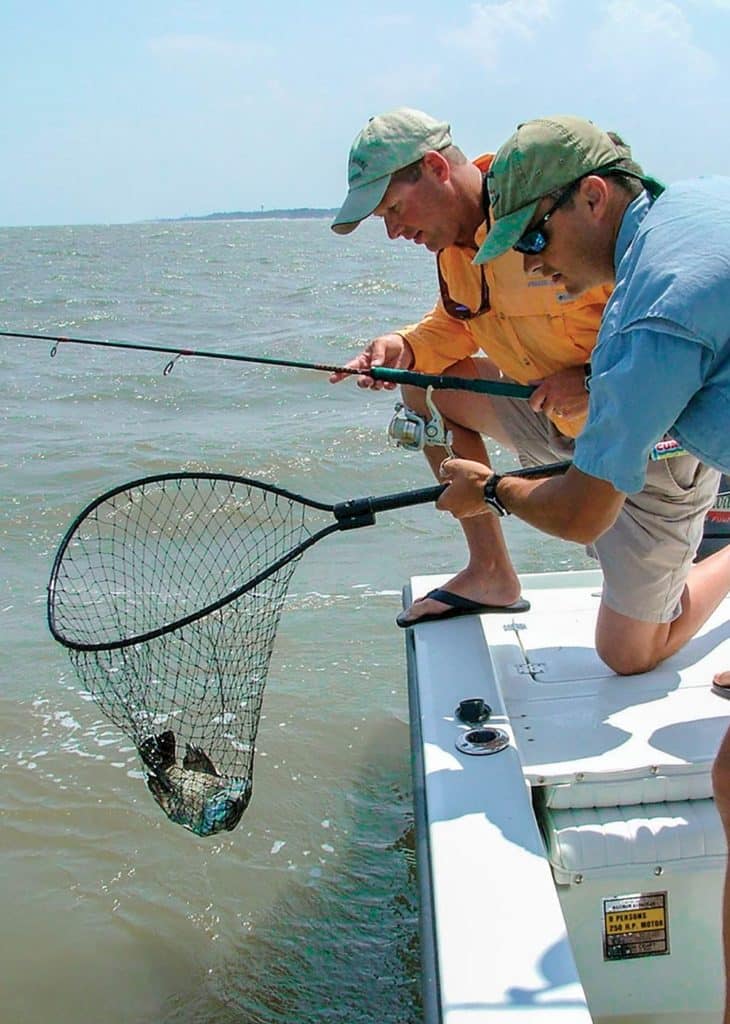Most of us load more rods and tackle on our boats than we actually need, yet we forget or simply choose not to carry the few items that facilitate boating and releasing the fish we catch. Space constraints, primarily an issue for small-boat owners, is the most frequent deterrent. But even some anglers who run large fishing boats consider stashing landing nets and gaffs a hassle. Luckily, a number of products now make it easy to keep such bulky items and other important endgame tools secured, organized and handy.

Landing Nets and Gaffs Capt. Glyn Austin runs inshore trips in the Indian River around Sebastian, Florida, as well as nearshore charters in neighboring coastal waters. “I carry a Frabill Power Stow telescoping net that collapses and folds so it fits in one of my boat compartments,” he says. “It’s big enough for netting bull reds and snook in the inlet or cobia offshore, so I don’t have to carry two or three nets.”
Capt. Brian Barrera, in South Padre Island, Texas, guides clients to snook, tarpon, redfish and trout in Laguna Madre and the Brownsville ship channel. He never leaves the dock without a 60-inch-handle Frabill landing net with a wide, deep rubberized bag. “I use it when a fish is barely hooked or it’s a special catch, like a customer’s first snook,” Barrera says. “I scoop and hold it in the net, still in the water, while everyone gets cameras or phones ready for the photos to minimize the stress on the fish, which is especially important in the heat of summer.”
Of course, for fish destined for the dinner plate, especially pelagics such as kingfish, tuna and dolphin, carrying one or more gaffs is essential. Should you have to settle for only one, pick a straight gaff with a 6- or 8-foot heavy-duty handle and a 3- or 4-inch hook. If storage aboard your boat is really limited and the gunwales are low, a 4-footer will do in a pinch.

Gaff and Landing-Net Stowage When stowing the landing net in a compartment is not an option, consider a set of hangers from Taco Marine or Tigress Outriggers and Gear to store it vertically on the side of the console, or on one of the various brackets available to store it horizontally on a bulkhead or gunwale. Stashing gaffs in horizontal rod racks under the covering boards is OK, but there are gaff-specific brackets and holders, such as those from Birdsall Marine and Deep Blue Marine Products, that keep the gaff hook covered for safety and utilize straps or bungees to secure the gaff shaft.
Dehookers and Gloves Austin also carries a couple of ARC and Rapala dehooker tools of different sizes for hands-free releases. The bend in the dehooker tip slides over the line and down to the hook. With a quick flip, the hook pops free and the fish falls back into the water. A 16-inch dehooker fits easily over jig heads as small as ¼-ounce for quick extraction.
“A Baker dehooker, a stainless-steel pistol-grip design, is another one of my go-to tools,” Austin explains. “If the fish swallows the hook deep, the length of the barrel allows me to reach down inside the throat to get it. The angled clamp inverts the hook so it’s easier to remove, and they’re awesome for removing treble hooks on plugs.”
Barrera is another fan of long dehookers, especially when handling toothy critters such as sharks and king mackerel, common catches for his anglers during the summer. “They let you go at a different angle to remove the hook. You can put pressure on the lead-head and rotate the barb. They’re good for tough-to-reach places.”
Read Next: Offshore Fishing Accessories
Of course, there are certain situations that call for some hand protection, for instance, when leadering sharks or billfish, or when landing and releasing tarpon.
“I use a pair of Fish Monkey gloves whenever I’m handling tarpon,” Barrera says. “The gloves protect my hands while I keep the fish boatside in my grasp to revive it for a healthy release. They’re also good for big jack crevalle. I like to hold jacks by the fork of the tail and drop them headfirst into the water to revive them. The gloves protect my hands from their sharp fins, avoiding possible infection.”
Storage Pocket Solutions Mesh storage pockets constructed with marine-grade canvas and webbing, such as Tacklewebs (tacklewebs.com), come in various sizes and configurations ideal for storing both dehookers and gloves. They take up minimal room and offer permanent or removable mounting options (using bungee or Velcro straps) suitable for otherwise unused areas, including bulkheads, coolers, the inside of hatches and doors, or the frame of a leaning post, T-Top, or poling or casting platform.
Lippers and Pliers While the misuse of lipping tools — usually hanging fish vertically from the jaw with no other support, which could cause internal injury — has sparked controversy, BogaGrip and similar lippers are good tools for securing and holding fish in the water trauma-free during hook removal and release.
Both Austin and Barrera strap pliers to their belts. Austin uses a pair of stainless-steel Van Staal pliers, while Barrera uses 7½-inch Premio titanium pliers when unhooking big speckled trout and redfish. Austin, however, opts for a dehooker first.
Tool Storage Options Several companies such as Boat Outfitters (boatoutfitters.com) and Deep Blue Marine Products (deepbluemarine.com) offer removable and permanent-mount holders made of durable Starboard and designed to accommodate lippers and pliers, either alone or in conjunction with other tools, to make the most of storage space.
In addition to the mentioned manufacturers of marine storage accessories, SeaSucker (seasucker.com) offers removable vacuum accessory mounts, featuring heavy-duty suction cups you can attach to any flat surface, for securing landing nets, gaffs, pliers and other essential tools.









